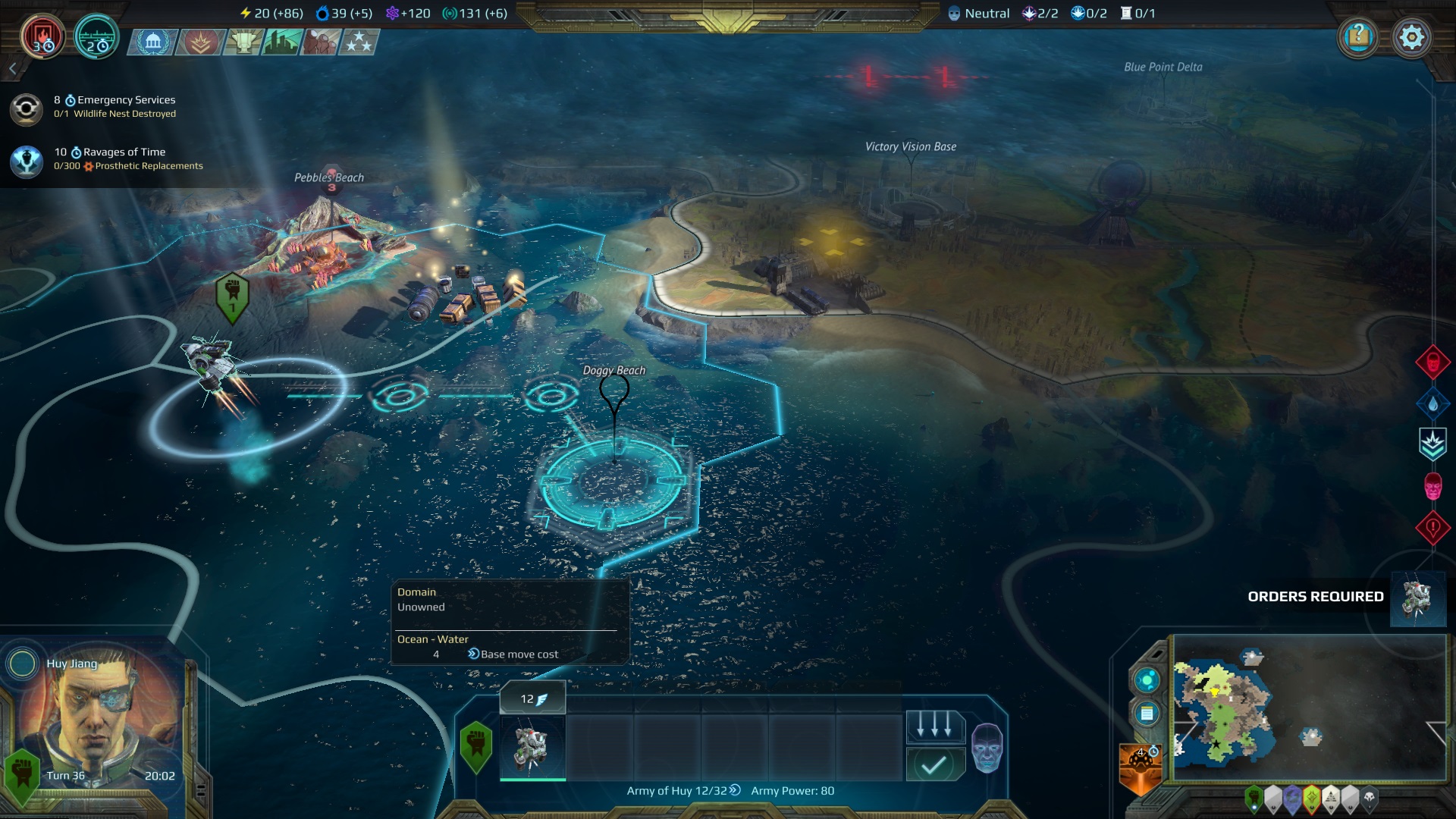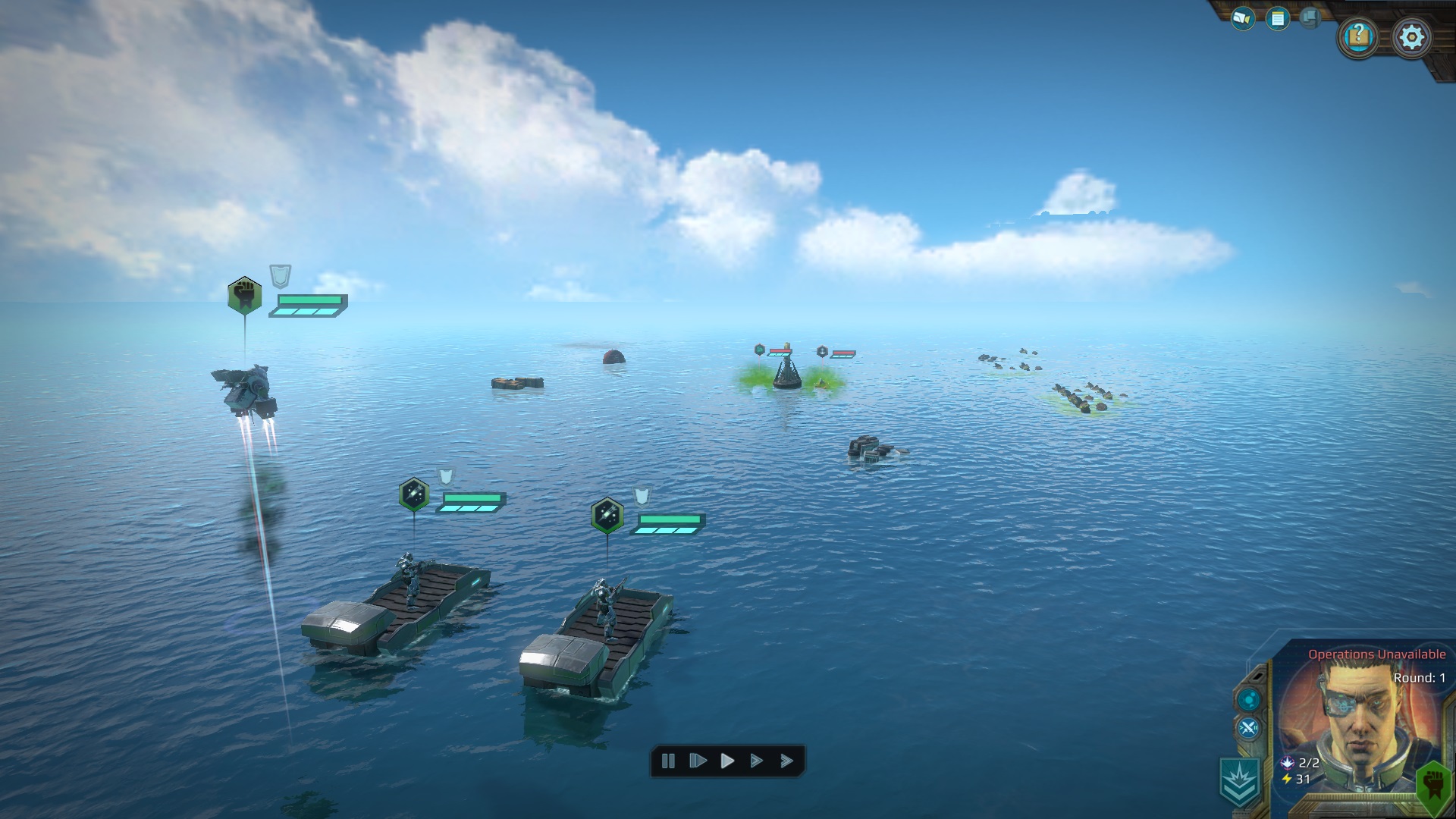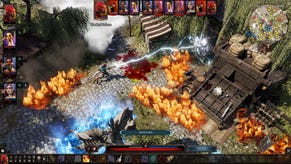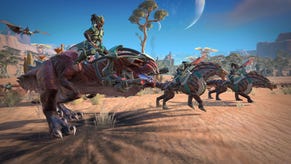Wot I Think - Age Of Wonders: Planetfall
A glowing space crystal in the rough
I’ll be honest, I came dangerously close to not recognising Age Of Wonders: Planetfall for what it is: a solid, well-designed strategy game. Like a jaded ogre examining bones for shreds of meat, I nearly tossed it aside with a grunt, letting it plonk down the bone-hill into the Steam refunds ossuary. But then, I would have missed out on the rich, dense marrow within.
Planetfall is a tactical combat game resembling a hex-based XCOM on a large scale, wrapped in a civ-like strategic layer (I’d call it a 4X, but given the term came from a 1993 preview of Master of Orion, I’m beginning to feel like either the term, or the genre, should move on). You spread your cities across the strategic map, doing all the usual stuff like moving up a tech tree, wiping out rogue NPC settlements, and gunishing or diploming your rivals. When said gunishment begins, it’s time to zoom into the contested hex, which becomes its own hex-based map (pleasingly faithful to what was there on the strategic scale) with the troops laid out ready for turn-based fun.
The connecting pin between both modes is your faction leader, an RPG-style-customisable figure who acts as both a hero unit in the tactical game, and a figurehead on the strategic level, changing your society bonuses and research options based on the perks you’ve picked for them.

This “tactics and strategy with a side of RPG” play has long been the staple of the well-regarded Age Of Wonders series, and I’m happy to say it’s flourished since developers Triumph Studios were picked up by Paradox in 2017 (you can tell it’s a Paradox title now because the diplomacy system features liberal use of the term 'Cassus Bellis'. It’s like a calling card).
And it all works bloody well. The tactical mode is tremendous fun, the strategic mode is serviceable-running-to-good, and they're tied together elegantly. There's quite a learning curve, but not in the frustrating way - there's just a lot to play with. From unit mods, to battlefield-altering hero abilities, to classic elemental damage and vulnerabilities, there’s a good depth of systems to master if you want to perform well on the battlefield.
You'll need to master them, too, as the AI is impressively competent, and will use all its tricks against you. While I found the strategic mode a little less exciting than the tactical, it soon picked up for me when I began thinking of it as a medium for developing better options on the tactical scale.
So why on earth, given all this quality, does Planetfall carry such potent Mediocre Game Energy?
The problem isn’t with the setting, which is actually quite well-conceived. In Planetfall’s post-cataclysm space opera, the galaxy’s worlds have been isolated for two centuries, after the interstellar empire governing them did a hubris and blew up hyperspace. Now, everything is suddenly connected again, and the various hyperadapted survivors of the disaster are racing to claim what they see as their birthright.

None of it is entirely free of cliché, but there’s an interesting take on all the classics. The Kir’ko, for example, are the only faction in the game not evolved from humanity, and are your classic insectile hiveminders with names that sound like a cement mixer full of nails put through a speech-to-text programme. They grow their buildings organically, develop units of all kinds from larvae, and… oh, they’re the Zerg, aren’t they?
Well, not quite. As you read more of the lore scattered around the game, it turns out they were discovered by humanity as a preindustrial culture, and had their hive minds lobotomised so they could be used as slave labour, ending up like the Prawns from District 9. With human civilisation collapsed, they’ve been on a long journey to try to discover a new identity for themselves in the vacuum left by the destruction of their culture. And now, with the galaxy reunited, they have to work out how (or whether) to reassemble their ancestral hivemind, and whether to reconcile with their former oppressors or destroy them.
There’s loads of stuff in the game like that. Mad max barbarians still reeling from the trauma of their descendants being unplugged from a utopian simulation. Horrific cyborgs who scavenge human organs and machine parts to make themselves living examples of the ship of Theseus. Space dwarves with a sort of dieselpunk Soviet fetish club aesthetic. Buff ladies riding laser dinosaurs. Good, nutritious nonsense, that occasionally feels like Borderlands, or more oldschool stories like Dune or Hyperion.

The problem is, there’s a lot of it, and it’s not really presented in any coherent order. The potted history of the bug squad back there was what I managed to piece together from unit descriptions, fragments of dialogue, and reading developer diaries during my lunch hour - because once I did figure out what was going on, I was actually quite compelled by it.
If I wasn’t tasked with reviewing the game, however, I probably wouldn’t have bothered to get that deep. The game’s setting is just sort of… blurted at the player in an amorphous torrent of generic SF set dressing. At first glance, it feels very much from the Avatar school of skin-deep bollocks, and things get even worse when the tutorial starts.
First there’s an intro cinematic of the sort where nothing really happens, and a wafty voice speaks cryptically about a great cataclysm, destiny among the stars, and things like that. Then, you’re ushered swiftly past all the bug lords and the tech-liches and plonked in front of Jack Gelder, a big square-jawed nobody with armoured knees and a Firefly duster. It’s like arriving solo to a houseparty full of strangers and being shoved into a conversation with the only other loner there, who turns out to be a dog strangler. A boring dog strangler.

Jack’s got all the dullest signifiers of being a “hero” (he’s white, he’s male, he’s a soldier, he’s called Jack, and his surname is an agentive nominalisation), without having any character to speak of - or any animations whatsoever while he’s talking. His 3D model just sways there, staring into the middle distance like a divorced dad watching his caravan burn down, while his dialogue plays out. The voice acting too, with Jack and across the board, is... not the best.
I can’t even remember what Jack’s up to in the tutorial. He’s going to a planet to check on… a thing. And it turns out… no, it’s gone. I can't remember. Not just because the tutorial story was ropey, but because just when I was starting to be able to focus on it, the tutorial pop-ups pounced on me like a second velociraptor from the undergrowth.

In this instance, the clever girl was AIVA (I think it was AIVA), the classic standard issue AI-assistant-with-an-acronym-for-a-name, who began by introducing herself and what her acronym stood for. Why is it always this? Why can't the tutorial narrator be a sneering woodlouse, or an anxious bird with a knife, or a dying god? Anyway, AIVA immediately began bombarding me with information on the game systems. Or more accurately, soliloquies. Because my goodness, they went on. It got to that point of willing self-destruction where you’re just mashing the escape key to get past it all.
Unfortunately, the visual elements (of the strategic map at least) weren’t doing a lot to recommend the game to me at this point either. While the game’s structures and units have had some excellent artistic design poured into them (the faux-sovet aesthetic of the Dvar in particular is meticulously well-observed), the landscape they live on feels cluttered and discordant at times, with the common sin of interpreting “science fiction” to mean “bobbing, glowing lights in loads of different colours, hovering over wrong-coloured grass, with crystals.”

I soldiered on through the first mission, and then quit out of the game for a bit, gathering my resolve to jump back in. In time, and in the interests of fairness, I did return to the campaign, and I found it got more interesting as more factions and facets of the world were introduced. After this review is filed, I’ll be keen to get back in and finish it off.
Even without that second look at the campaign, however, I would probably have come round to Planetfall. Deciding to give up on the story, I jumped into a multiplayer session with RPS video person Astrid, figuring that the best way to pick up the game would be a mixture of civ-honed instinct, and good, old-fashioned trial and error while playing on a team with a mate.
Given time constraints, we only got to play for a few hours, but it was a blast. The wildly differing strengths and unit compositions of the various factions, and the cunning system wherein allied armies on adjacent hexes can be drawn into a tactical combat, made for a rewarding co-op session.
My Kir’ko, having declared war on an NPC faction of VR-addled berserkers, were getting whomped in tactical combat - and so we pulled back while Astrid brought in a division of Dvar drill-tank things. We managed to come at the enemy stronghold from two sides, allowing for a really satisfying dust-up where the hammer of my fookin’ prawns smashed the barbarians against an anvil of space-dwarven steel.
It was during this battle, while Astrid was taking their turns, that I started reading through the unit descriptions - and that I started feeling immersed in the game at last. I’m glad I did. Civ 6 will probably remain my hex-em-up of choice for the foreseeable future, as I’m more into the strategic game, and War of the Chosen will still be my go-to for turn-based tactics. But on the days where I’m not sure which Firaxis golden goose to caress for eggs, Planetfall will be a fine in-betweener.

I guess the big thing I took away from Planetfall was the importance of first impressions. If I was to contrast it with anything, it would be Gladius, the Warhammer 40k 4X that came out last year. If there’s a setting I’m familiar with, it’s 40k (I write books for Games Workshop, so you’d bloody hope I'd be familiar), so I jumped into that game like a dog into a comfy basket. What I found, however, was an utterly underwhelming, atmosphere-free desert of hexagons that even my beloved Necrons couldn’t make me feel engaged with. And yet I persisted for hours due to my affection for Warhammering.
With Age Of Wonders: Planetfall (and I’m using its full name to underline the fact that its title doesn’t do any favours in dispelling the ‘generic SF’ vibe), I found the opposite - a glimmering space crystal, including some great story elements, buried under a patina of lowest-common-denominator grime. A lovely bone, full of marrow, specially formulated for growing ogres. Don’t make the mistake I nearly made and disregard it: if you enjoy the tactical and strategic game styles it draws from, you’ll find a game that doesn’t go out of its way to innovate on either front, but one that performs a bloody lovely duet.
And there’s giant women on laser dinosaurs. Go on: have a look.







